NOTE: An archive of the Musings of an Iraqi Brasenostril on Jihad column can now be found here.
–
Bay’ah to Baghdadi: Foreign Support for Sheikh Abu Bakr al-Baghdadi and the Islamic State of Iraq and ash-Sham
By Aymenn Jawad Al-Tamimi
Click here for a PDF version of this post
Over the past couple of months, jihadi media outlets have circulated numerous photos and statements indicating support from various places abroad for Sheikh Abu Bakr al-Baghdadi and the Islamic State of Iraq and ash-Sham (ISIS) as the group has expanded its influence in Syria and has experienced a resurgence in Iraq. Below is a selection of those gestures of support, and the analytical implications.
Saudi Arabia
The gestures of support from Saudi Arabia primarily take the form of anonymous individuals holding placards declaring admiration for ISIS. Note that the photos below are not in chronological order. The ideological inclinations of the placard-holders are made clear by calling Saudi Arabia ‘Bilad al-Haramain’ (‘Land of the Two Sanctuaries’- referencing Mecca and Medina).
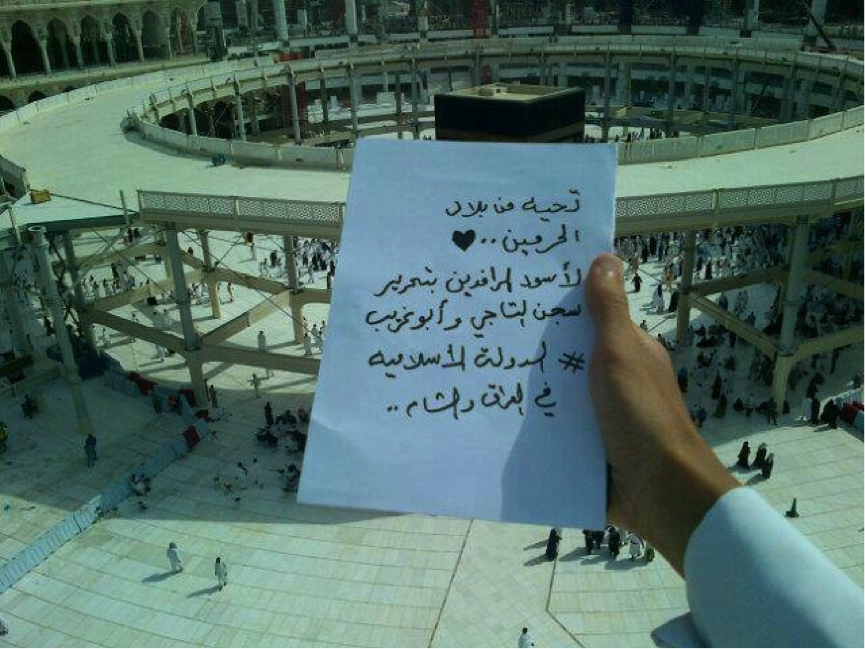
This photo, taken near the Kaaba in late July, celebrates the successful prison breaks orchestrated by ISIS at Abu Ghraib and Taji in Baghdad that resulted in the release of hundreds of detainees, including muhajireen who had been imprisoned since 2006/7. The placard reads: ‘Greetings from Bilad al-Haramain to the lions of the two rivers [Tigris and Euphrates] for the liberation of Taji and Abu Ghraib prison; for the Islamic State of Iraq and ash-Sham’.
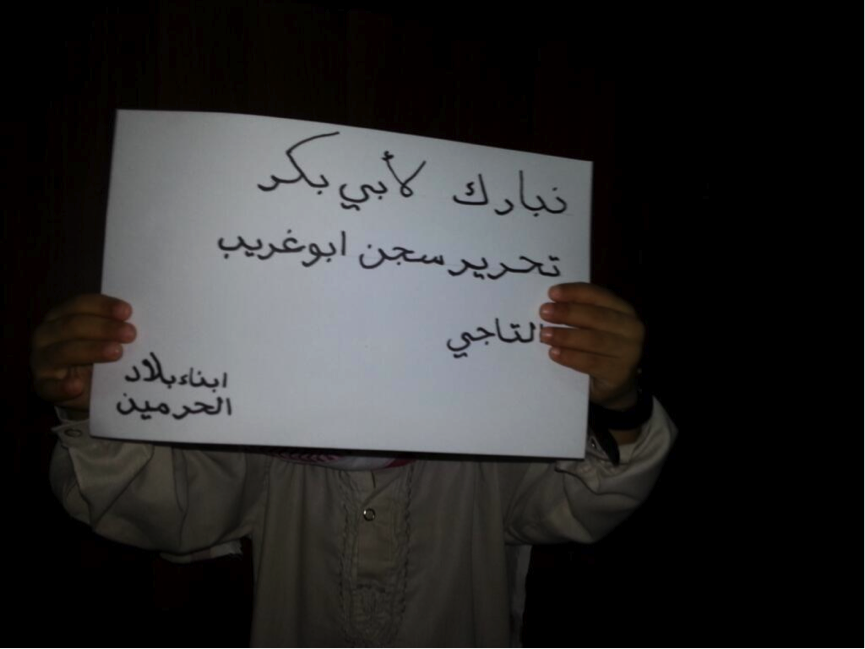
This photo comes from an unspecified location in Saudi Arabia. The placard reads: ‘We bless/congratulate Abu Bakr [al-Baghdadi] for the liberation of Abu Ghraib and Taji prison. The sons of Bilad al-Haramain.’
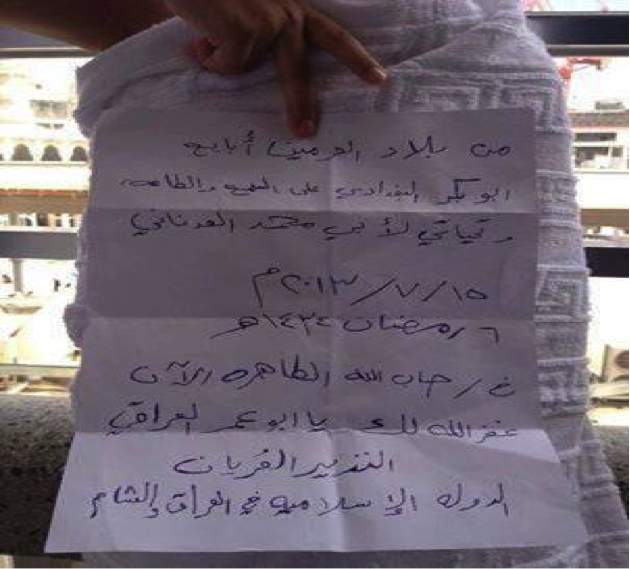
Again with unspecified location in Saudi Arabia, and the handwriting is not entirely clear, but the first few lines can be discerned as follows: ‘From Bilad al-Haramain, I pledge allegiance to Abu Bakr al-Baghdadi…and my greetings to Abu Mohammed al-Adnani [ISIS’ main spokesman].’
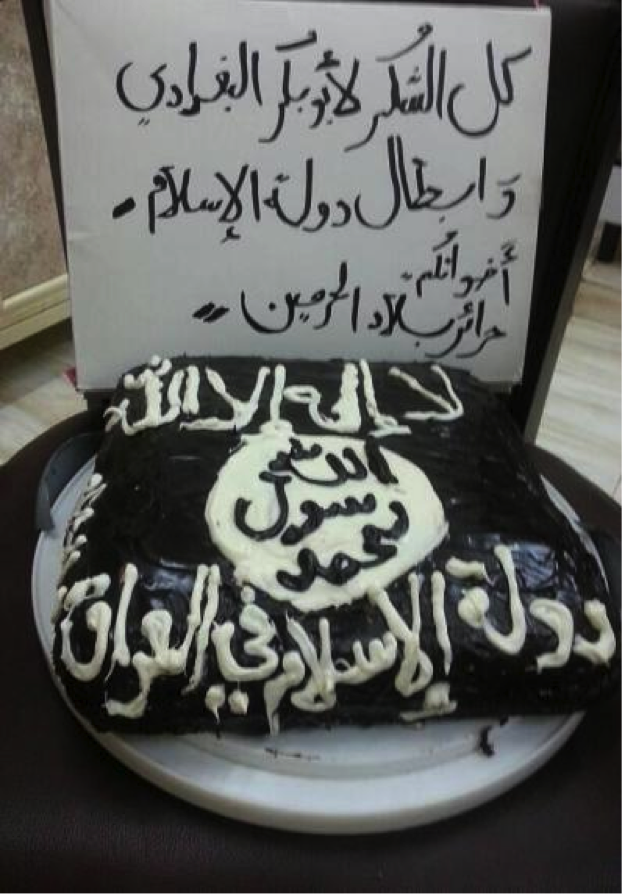
Perhaps one of the more bizarre demonstrations of support for ISIS from Saudi Arabia, a cake baked with the ISIS flag for the icing. The dedicatory placard reads: “All thanks to Abu Bakr al-Baghdadi and the heroes of the Islamic State. Your brothers…the free men of Bilad al-Haramain.”
An earlier image of an ISIS cake from Saudi Arabia had appeared with an accompanying explanation that it was baked to celebrate the fact that a Saudi family’s son was heading off to Syria to fight jihad. However, that image and the Facebook page that featured it have since been deleted.
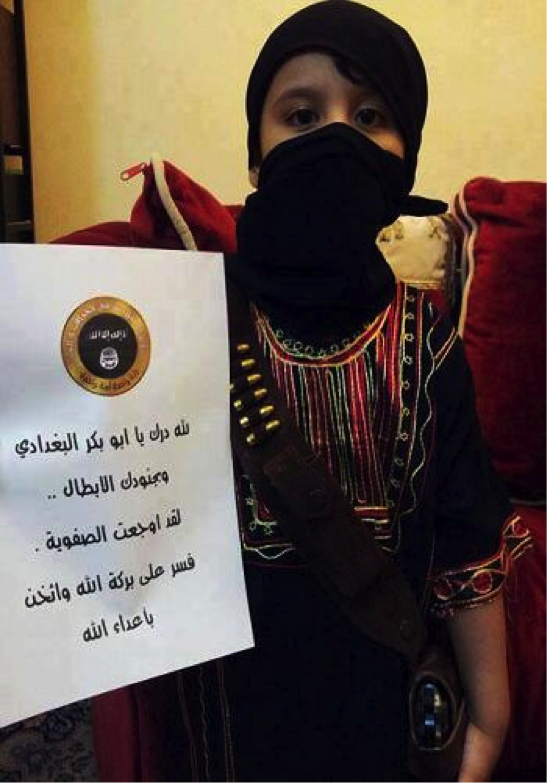
A photo released on a jihadi forum as part of the same set as the ISIS cake above. A young Saudi girl holds a placard with ISIS insignia. The first and relevant part of the placard reads: ‘How excellent you are, Abu Bakr al-Baghdadi and your heroic soldiers! Verily you have caused pain to the Safavids.’ In this context, the term ‘Safavids’ is a derogatory reference to the Shi’a.
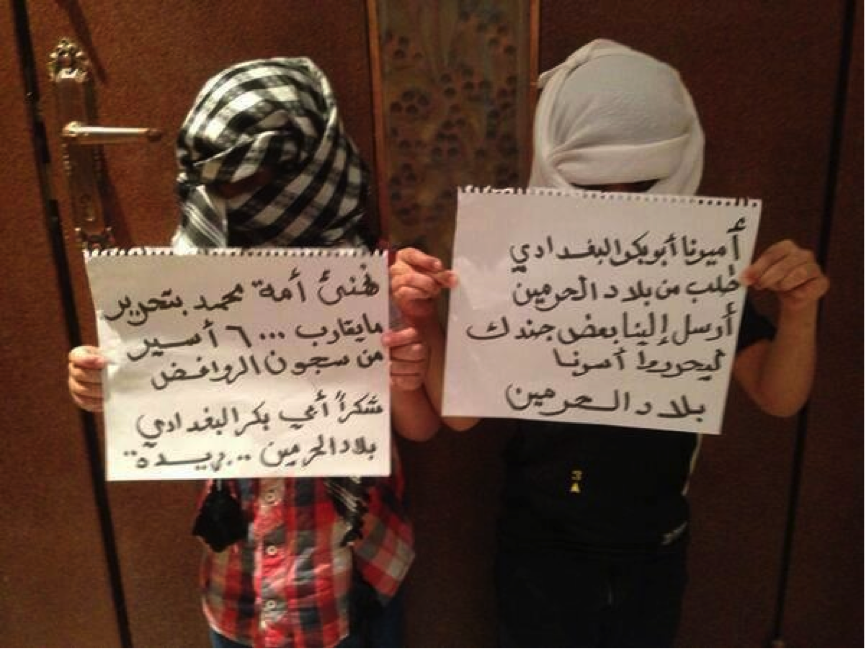
Two Saudi children hold placards celebrating the ISIS jailbreaks in Baghdad. The placard on the left reads: ‘We congratulate the Ummah of Mohammed for the liberation of some 600 prisoners from the prisons of the Rafidites [Shi’a]. Thanks to Abu Bakr al-Baghdadi. Bilad al-Haramain.’ The placard on the right says: ‘Our amir Abu Bakr al-Baghdadi…send us some of your soldiers to free our prisoners. Bilad al-Haramain.’
Testimony on the ground from northern Syria in particular suggests to me that one factor behind ISIS’ success in expansion is that the group has much more financial clout at its disposal than most other rebel factions, such that first-hand observers seem puzzled. Cross-border coordination with mujahideen in Iraq and limited oil revenues from control of some oil fields in Syria can partly explain the depth of ISIS’ financial resources. Yet I would also suggest that by conveying these gestures of support from Saudi individuals to ISIS, jihadi circles are implying that ISIS is receiving significant funding from private Saudi citizens who support ISIS.
Somalia
Somalia, home to the official al-Qa’ida affiliate Harakat Shabaab al-Mujahideen (HSM), has also seen gestures of support for ISIS and Sheikh Abu Bakr al-Baghdadi. The images below have been released through the end of July and into August by the pro-ISIS media channel ash-Sham, which is based in Raqqa, Syria. There have of course been rumors and anecdotes of Somali fighters in Syria. Somalia itself has also seen small demonstrations in support of the uprising in Syria.
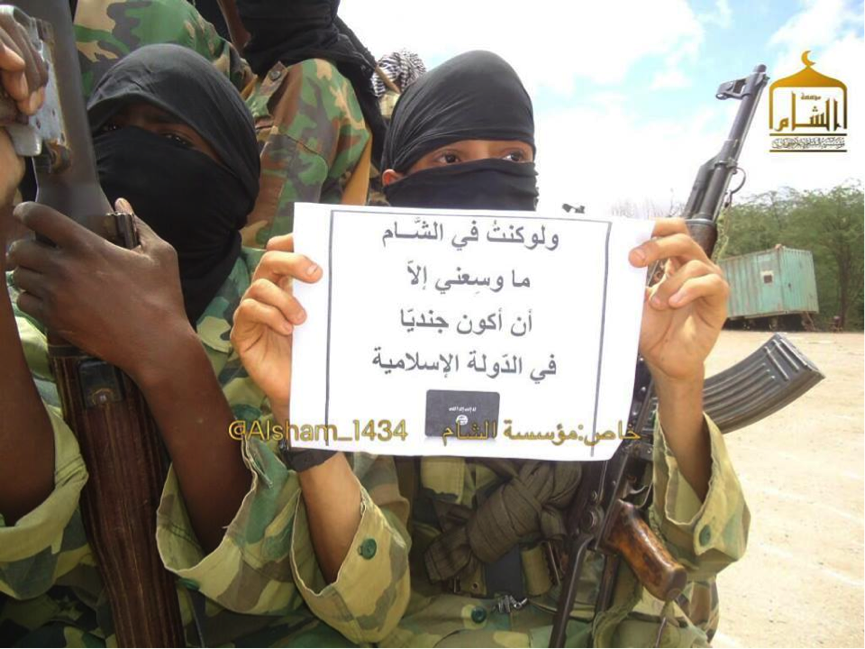
The ash-Sham channel’s logo is to be observed in the right-hand corner. The placard held by the HSM fighter reads: ‘And if I were in ash-Sham, I could only be a soldier in the Islamic State.’
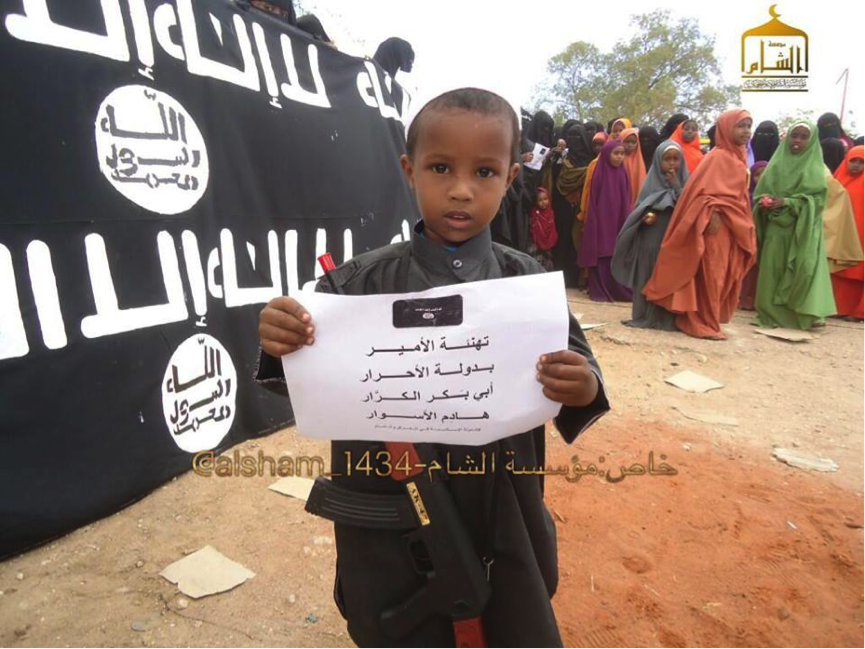
A child supporter of HSM stands besides a large ISIS/HSM banner, holding a placard that reads: ‘Greetings to the amir in the state of free men: Abu Bakr al-Baghdadi, demolishing the walls.” Note that ‘demolishing the walls’ is in reference to the successful ISIS jailbreaks in Baghdad last month.
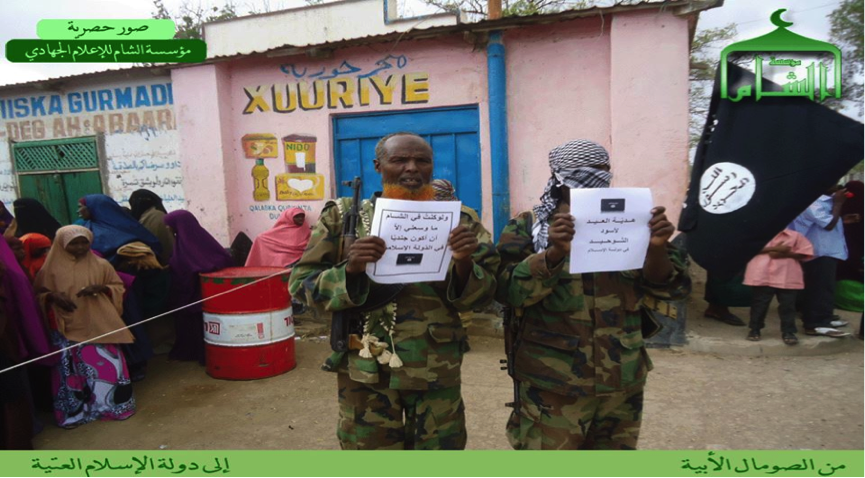
Two HSM fighters show their support for ISIS. The mujahid on the left displays the same placard as in the first photo from this series. The mujahid on the right holds a placard that says, ‘An Eid gift to the lions of Tawhid in the Islamic State.’ The building behind the two HSM fighters has the Somali word ‘Xuuriye’ inscribed on it, meaning ‘freedom’ and borrowed from Arabic (in Somali writing, ‘x’ replaces Arabic ḥ in loanwords).
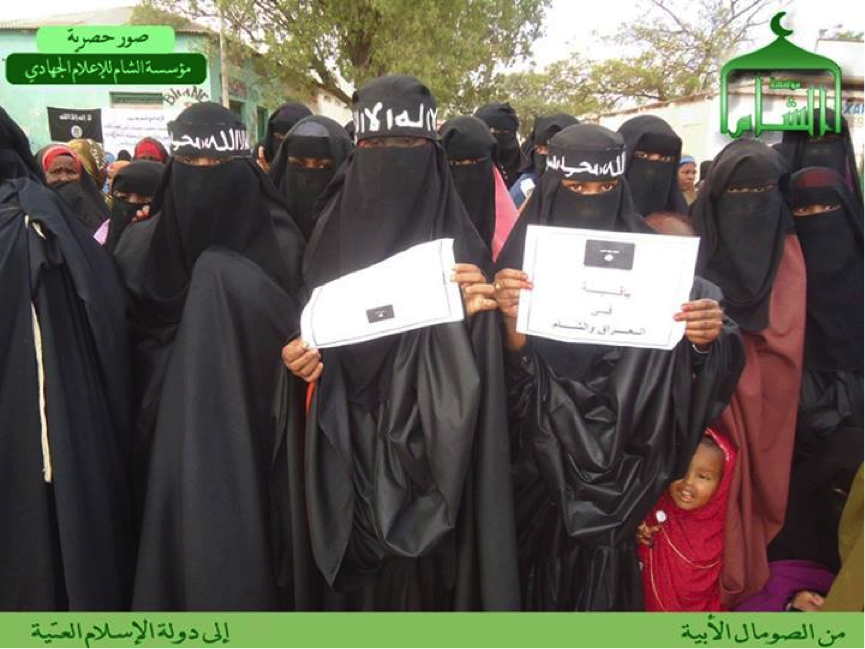
Niqab-wearing supporters of HSM demonstrate their support for ISIS. The placard on the right reads, ‘Remaining [steadfast] in Iraq and ash-Sham.’ It should be noted that this slogan is a recurring theme in ISIS discourse, originating from Sheikh Abu Bakr al-Baghdadi’s speech in June, in which he rejected Sheikh Aymenn al-Ẓawahiri’s insistence on separation between Islamic State of Iraq and Jabhat al-Nusra. Since then, ‘bāqīya’ has even become the name of a pro-ISIS media outlet: Bāqīya Media, dedicated to putting out material on ISIS in Bilād ash-Sham.
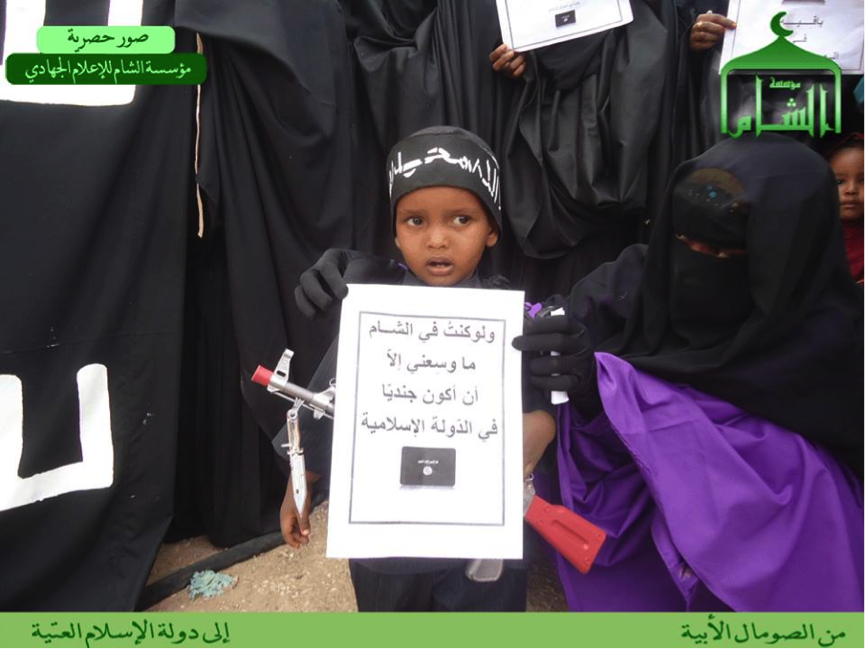
A Somali child holds the same placard as in the first photo in this series.
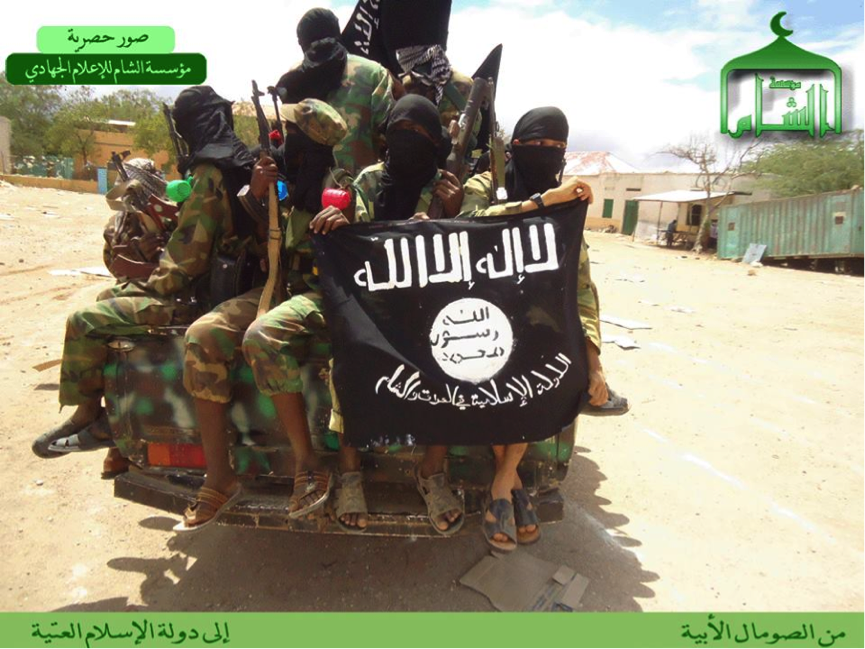
HSM fighters hold the ISIS banner with the inscription ‘Islamic State of Iraq and ash-Sham’ on it.
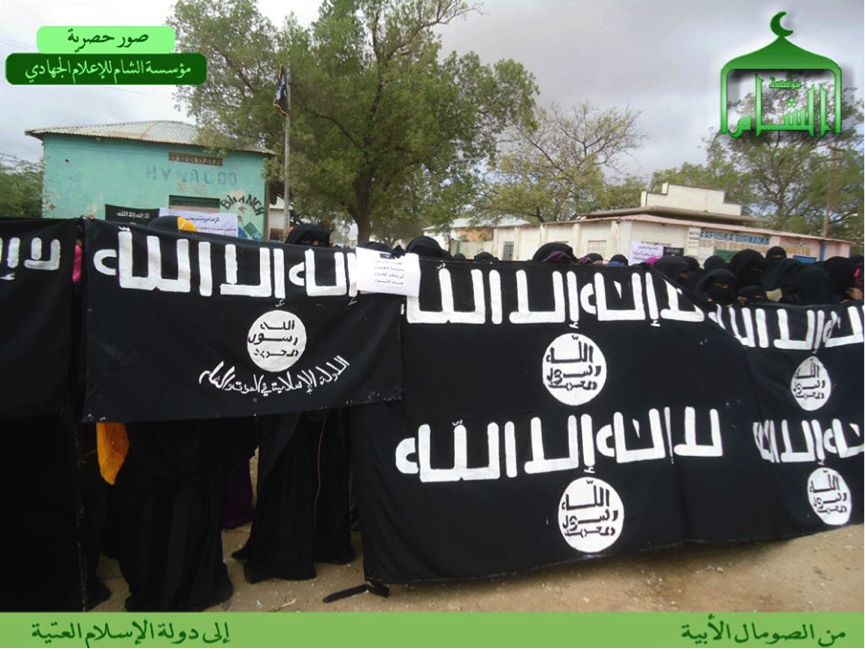
Somali women in niqabs display ISIS banners. Note the one on the left with the inscription ‘Islamic State of Iraq and ash-Sham.’
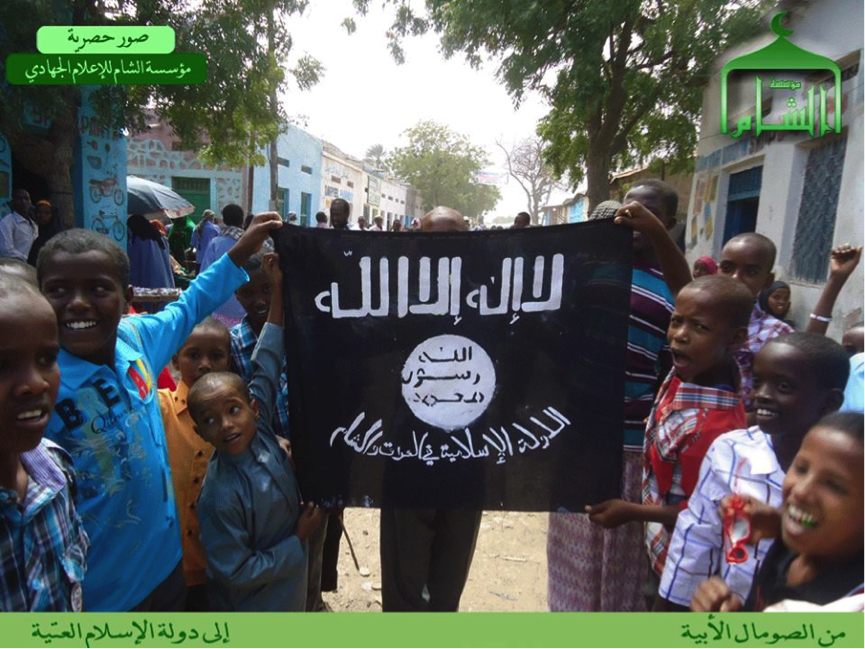
Somali children hold the ISIS banner.
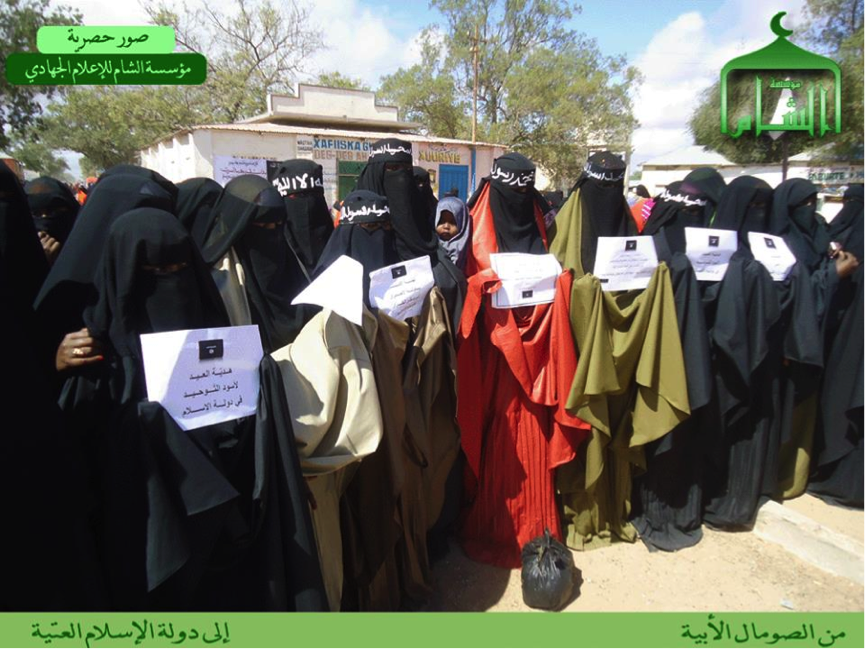
Somali women hold placards in support of ISIS. The writing on the discernible placard on the far left is the same as the third one in this series.
Given HSM’s status as an al-Qa’ida affiliate, it is noteworthy that its members and fan-base have shown support for ISIS and Sheikh Abu Bakr al-Baghdadi, while not indicating any similar appreciation for Sheikh Abu Mohammed al-Jowlani and Jabhat al-Nusra.
This would seem to suggest that ISIS’ reputation is far greater than that of the latter two in many jihadist hotspots around the Muslim world- something that has no doubt been abetted by ISIS’ quick expansion across northern and eastern Syria in particular, along with ISIS’ leading role in recent rebel offensives like the capture of Mannagh airbase.
Despite Sheikh Ẓawahiri’s indication of the need to dissolve ISIS, not only are al-Qa’ida affiliates elsewhere acknowledging ISIS and Sheikh Baghdadi as the leader of the jihad in Bilad ash-Sham, but also official jihadi forums like Shamūkh Islām no longer appear to be deleting posts put out in ISIS’ name.
That said, al-Furqān media- the official outlet of what was Islamic State of Iraq- still avoids overt reference to the name ‘Islamic State of Iraq and ash-Sham’ in its current video releases, even as it is becomes clear that ISIS’ jihad in Syria is being promoted (e.g. the interview with the martyred French convert and another with an elderly mujahid for the group).
In any event, it is clear that ISIS is more or less accepted in jihadi circles now as a reality on the ground, and Sheikh Ẓawahiri is unlikely to issue another directive calling for the disbandment of ISIS. As my friend Oskar Svadkovsky suggests, it is likely that Sheikh Baghdadi would simply reject the ruling again, and thus Sheikh Ẓawahiri would feel humiliated.
In effect, Sheikh Baghdadi has therefore extorted a concession from Sheikh Ẓawahiri, rather in the manner that Pompey the Great extorted a triumph out of Sulla in the late 80s BC after campaigning in Africa and Sicily against Sulla’s enemies. Both of these moves amount to a successful challenge to one’s political superior.
In any case, I would also say that Sheikh Ẓawahiri has decided on balance that the disagreement between Sheikh Jowlani and Sheikh Baghdadi is unlikely to spill into open conflict between Jabhat al-Nusra and ISIS where the two groups are evidently separate entities (e.g. Aleppo city and its outskirts).
Tripoli, Lebanon
Tripoli- marked by sectarian tensions between Sunnis and Alawites– has long been known as an area of greater Sunni religiosity than other parts of Lebanon. For years, observers who have been on the ground (e.g. my friend and colleague Phillip Smyth) have noted the regular appearance of the black flag of jihad at rallies.
Further, the town saw violent riots during the controversy over the anti-Islam film ‘Innocence of Muslims,’ culminating in the burning of a fast-food restaurant. More recently, the town has seen indications of a growing contingent of support for ISIS and Sheikh Baghdadi. It is of course true that the banner of what is now ISIS existed in Tripoli before ISIS was announced, and so the more recent gestures of support can be seen as a natural outgrowth of the already existing pro-al-Qa’ida sentiment that is now being bolstered by ISIS’ overall advances in Syria.
At the end of July, a message was circulated in jihadi media circles addressed to ‘our lord Abu Bakr al-Baghdadi of the Islamic State of Iraq and ash-Sham, may God protect him’ from the ‘wounded Tripoli of ash-Sham.’
The message goes on to speak of ‘love of you and of your soldiers’ and praises Sheikh Baghdadi and his men for having freed the ‘Ummah of Islam’ from humiliation. Documenting the sufferings of Sunni Muslim youth in Lebanon, the message of support ends with a personal pledge to Sheikh Baghdadi to be his ‘faithful soldiers.’
In a similar vein, Facebook (FB) pages dedicated to the Sunni community in Tripoli feature the ISIS banner to indicate ideological affiliation, as can be seen in the photos below. Noteworthy are the thousands of likes these pages have received.
While it may be the case, as Diana Rudha ash-Shammary suggests to me, that many of these likes come from fake accounts or duplicates, the numbers must reflect in some way a significant support base for ISIS in Tripoli, especially when corroborated with other evidence.
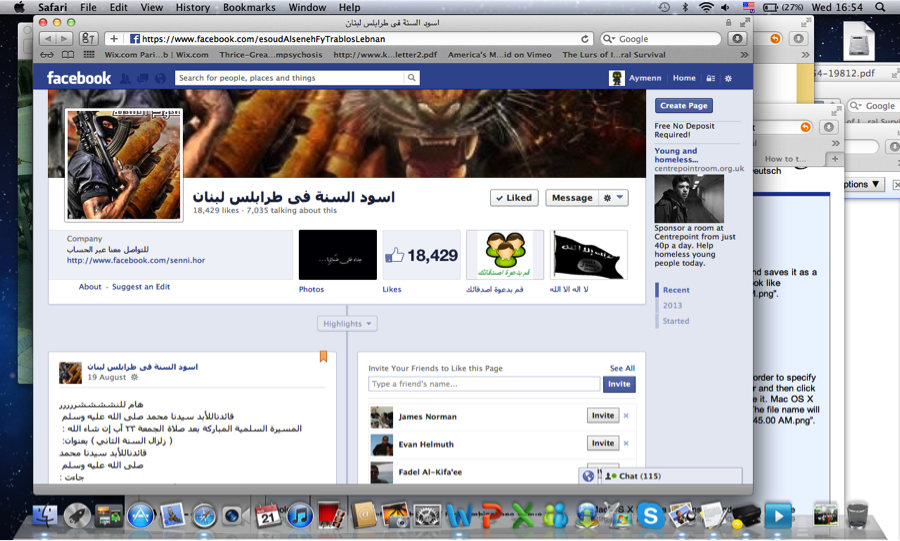
The FB page above is entitled ‘Lions of the Sunnah in Tripoli, Lebanon.’ Note the ISIS banner on the right-hand side.
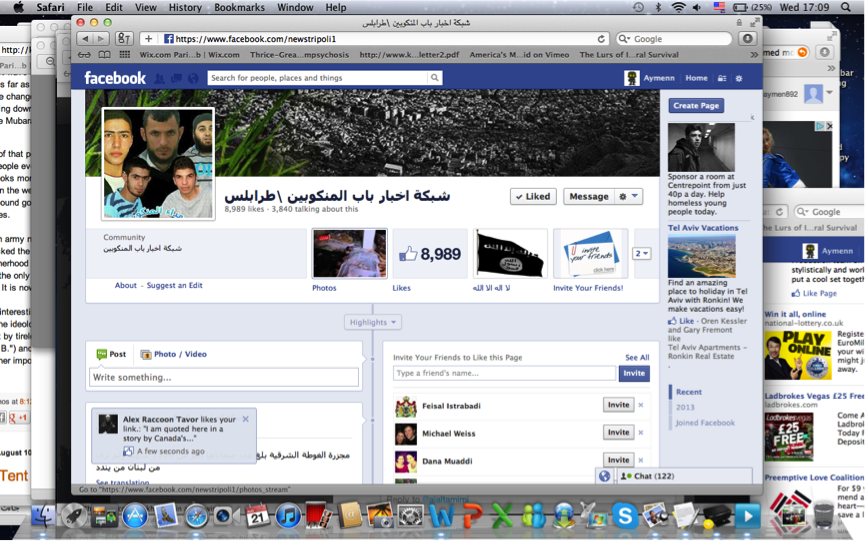
Another Tripoli-based FB page entitled ‘Bab al-Mankubis News Network, Tripoli.’ Note again the ISIS banner featured.
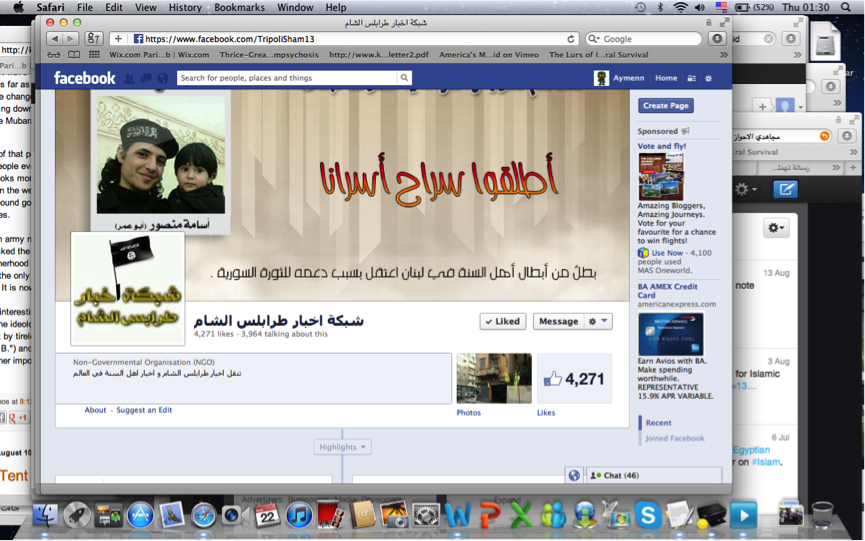
Another pro-ISIS FB page from Tripoli: ‘Tripoli ash-Sham News Network.’ Note the use of the ISIS flag in the main logo and the identification of Tripoli as a part of ‘ash-Sham’ (‘the Levant,’ in this context), indicating the hope for the jihad in Syria and cause for an Islamic state there to be brought to Lebanon.
All of these pages regularly reprint statements from ISIS. Thus, for the recently failed Latakia offensive into Alawite territory that was launched by ISIS, Jabhat al-Nusra and Salafi groups, the second FB page featured a statement from ‘our lord Abu Bakr al-Baghdadi (may God protect him): We are striving for there to be Eid prayers in al-Qardaḥa.’
This statement should illustrate what the ultimate purpose behind the Latakia offensive was. Far from being an area of vital strategic importance, the aim was instead to score a symbolic and psychological victory against the regime by aiming to capture the Alawite heartland and Assad’s ancestral village in particular.
In addition to this online material, videos have also emerged recently from Tripoli showing the ISIS banner. For example, on 9 August, a video was posted on Facebook of a demonstration in Tripoli for Islamist inmates imprisoned at Roumieh prison in Lebanon- an issue that has been around for quite some time.
In the video, entitled ‘Victory march of the oppressed in Roumieh,’ demonstrators can be seen holding ISIS banners. It is quite possible that the inspiration for this demonstration comes from the ISIS jailbreaks in Baghdad the previous month.
This year’s Eid celebrations also saw the ISIS banner on display in Tripoli’s Sunni areas. Here is a video of an Eid al-Fiṭr sermon earlier this month in the open in Tripoli, featuring a preacher behind a large ISIS banner. The channel that uploaded the video entitles the sermon, ‘The thrones of the Rafidites and idolators have shaken.’
In the sermon itself, standard Sunni Islamist rhetoric abounds, with reference also to the struggles of ‘our brothers in Syria,’ denunciations of Hizballah as ‘Hizb ash-Shaytan’ (‘the party of Satan’). The sermon itself is likely to have taken place in the area of Bab Tabbaneh, which had large Eid prayers in the open under the ISIS banner, as seen in the photo below.
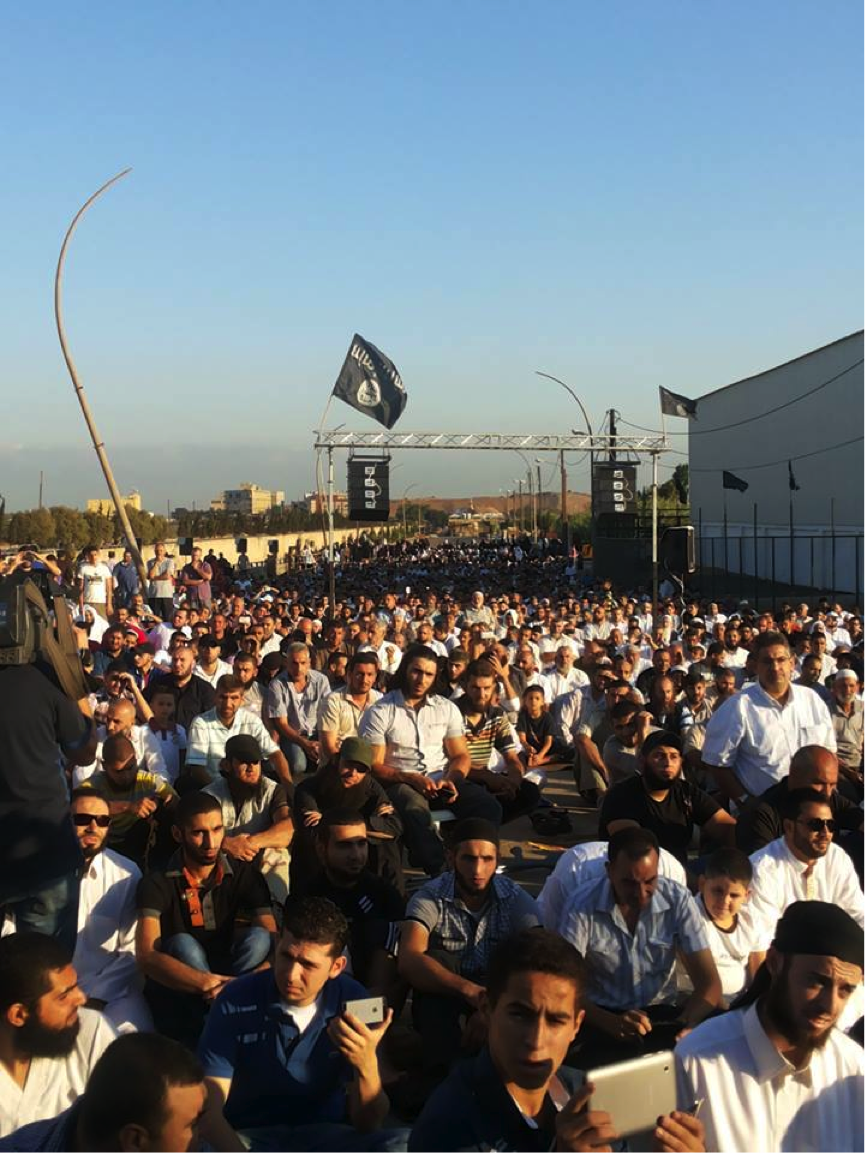
Below is another photo featuring young ISIS supporters in Tripoli after Eid prayers. Note the gesture with their fingers (the ‘finger of Tawhid’) is a standard feature of these ideological circles:
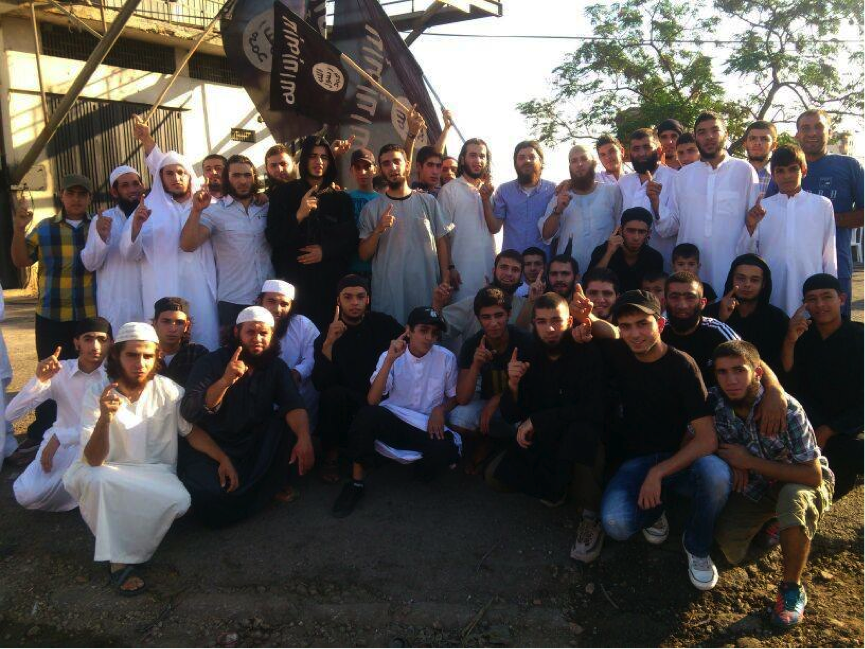
Had the ISIS-led offensive in Latakia succeeded, there would likely have been a flare-up in sectarian clashes in Tripoli. However, there is not even good evidence of large numbers of Alawites having been killed in the offensive despite the initial successes entailing the capture of a number of Alawite villages, as the inhabitants appear to have fled before they could be captured.
Observers would do well to keep a close eye on ISIS actions vis-à-vis Alawite areas of Syria and how future flares-up in violence in Tripoli, which are inevitable given the city’s status as a sectarian hotspot in Lebanon, might correlate with those events.
Other Areas: Ahwaz and Sinai
The data for Ahwaz and Sinai vis-à-vis ISIS are less extensive. This month, mujahideen in Ahwaz (Khuzestan: a part of southwestern Iran with a substantial ethnically Arab component) blew up an Iranian gas pipeline, and various outlets cited an anonymous activist from Ahwaz with the following message: ‘Our land is occupied and the Syrian people are living in the shadow of a dictatorial regime serving the interests of Iran in the region. When Bashar falls, so too will Iran and this is the motto of Ahwaz.’
The armed group that took credit for the attack- the Mohi ad-Deen Martyr Battalions– likewise accused the ‘Safavid state’ of being responsible for shedding the blood of the Ahwazi Arabs’ ‘Syrian brothers.’
Elsewhere, some pro-ISIS Facebook pages circulated a purported message of support and congratulations from mujahideen in Ahwaz to ISIS, though most of the pages hosting that message appear to have been deleted on account of censorship. Yet it has been preserved on a public Facebook page known as ‘Anṣār ash-Shar’īa in Ahwaz’ (see screenshot below).
Like other groups using the name ‘Anṣār ash-Shar’īa’ in the Arab world (e.g. Libya and Tunisia, both of whose local branches have indicated support for ISIS, besides the considerable number of Tunisian and Libyan mujahideen who have joined ISIS’ ranks), Anṣār ash-Shar’īa in Ahwaz uses the ISIS logo.
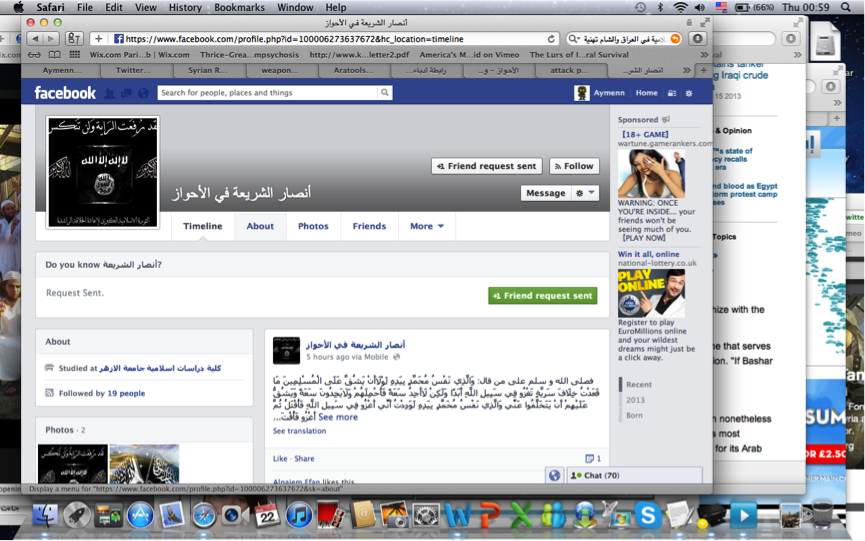
The relevant part of the purported message of support from Ahwaz mujahideen to ISIS reads thus: ‘Message of congratulations from the mujahideen of Ahwaz to the Islamic State of Iraq and ash-Sham and its amir al-Baghdadi. May Allah prolong his life, strengthen him, and give him and the mujahideen total victory on this Eid Mubarak.’
One should not of course extrapolate too much from these rather limited data points. Indeed, attempting to determine numbers of Ahwazi Arab supporters of ISIS and the wider jihad in Syria would be a futile exercise. Nonetheless, one can say that there are indications of a growing more general trend of Ahwazi militants to tie their struggle to that of Sunnis in Syria and a part of that trend to identify with the jihad of ISIS and its efforts to establish a Caliphate.
As for the Sinai, the gesture of support for ISIS is limited to an image below doing the rounds on pro-ISIS social media pages, purporting to show jihadists in the Sinai pledging allegiance to ISIS. In the grand scheme of the wider jihad in the Sinai since the coup that deposed Morsi, this photo and the purported explanation for it mean very little. Yet depending on ISIS’ long-term success, it would not be all that implausible if some ISIS muhajireen in particular eventually decide to bring armed struggle to Egypt beyond the Sinai with support from Sheikh Baghdadi.
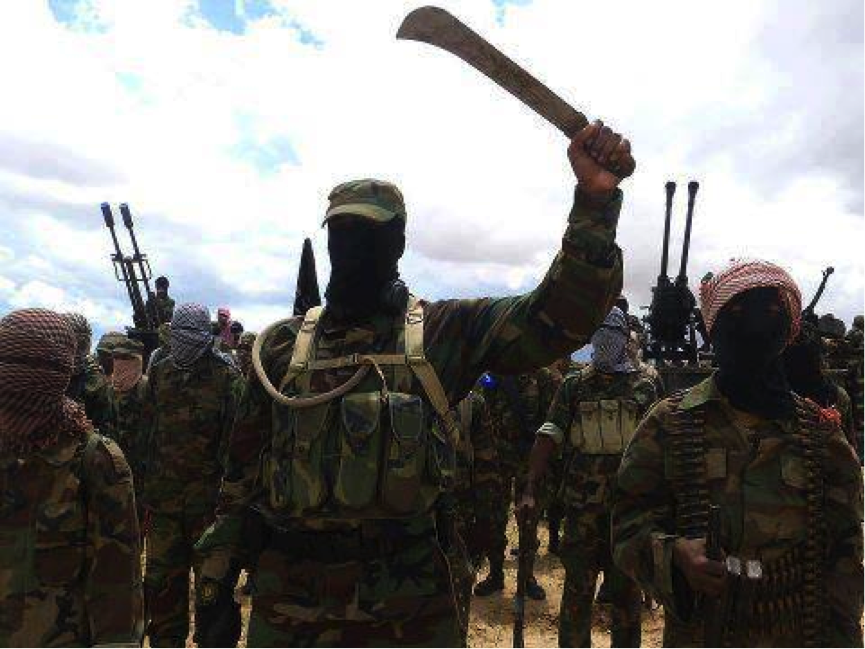
Overall Conclusions
From this survey, the main points of analysis are as follows:
1. In showing gestures of support for ISIS from Saudis in particular (as opposed to other areas of the Arabian Peninsula), pro-ISIS circles are likely indicating an important source of funding for ISIS- something that would help explain why the group has such great financial clout in Syria, even in light of cross-border coordination with mujahideen in Iraq and control of some oil fields in eastern Syria.
2. There are no comparable placards and other demonstrations of support for Jabhat al-Nusra and Sheikh Jowlani. As ISIS has become established as a reality on the ground in Syria and expanded its power, so its reputation has gained strength and acceptance among the international jihadi community and arguably eclipsed Jabhat al-Nusra.
Similarly, Sheikh Baghdadi seems to enjoy greater prominence than Sheikh Jowlani. In short, any hopes of reverting to the old status-quo of a separate Islamic State of Iraq appear to be dissipating. It could therefore be said that Sheikh Baghdadi has successfully challenged Sheikh Ẓawahiri.
3. Pro-ISIS sentiment appears to be growing in Tripoli, Lebanon in particular. This is cause for concern as regards the prospects of future and more intense outbreaks of sectarian violence in the city, depending on ISIS’ future progress within Syria.
Aymenn Jawad Al-Tamimi is a Shillman-Ginsburg Fellow at the Middle East Forum. His website is https://www.aymennjawad.org. Follow on Twitter: @ajaltamimi. All translations from Arabic here are his own.
Musings of an Iraqi Brasenostril on Jihad: Bay’ah to Baghdadi: Foreign Support for Sheikh Abu Bakr al-Baghdadi and the Islamic State of Iraq and ash-Sham
Posted on

Hat dies auf BinDerStefan.com rebloggt.
Reblogged this on pietervanostaeyen.